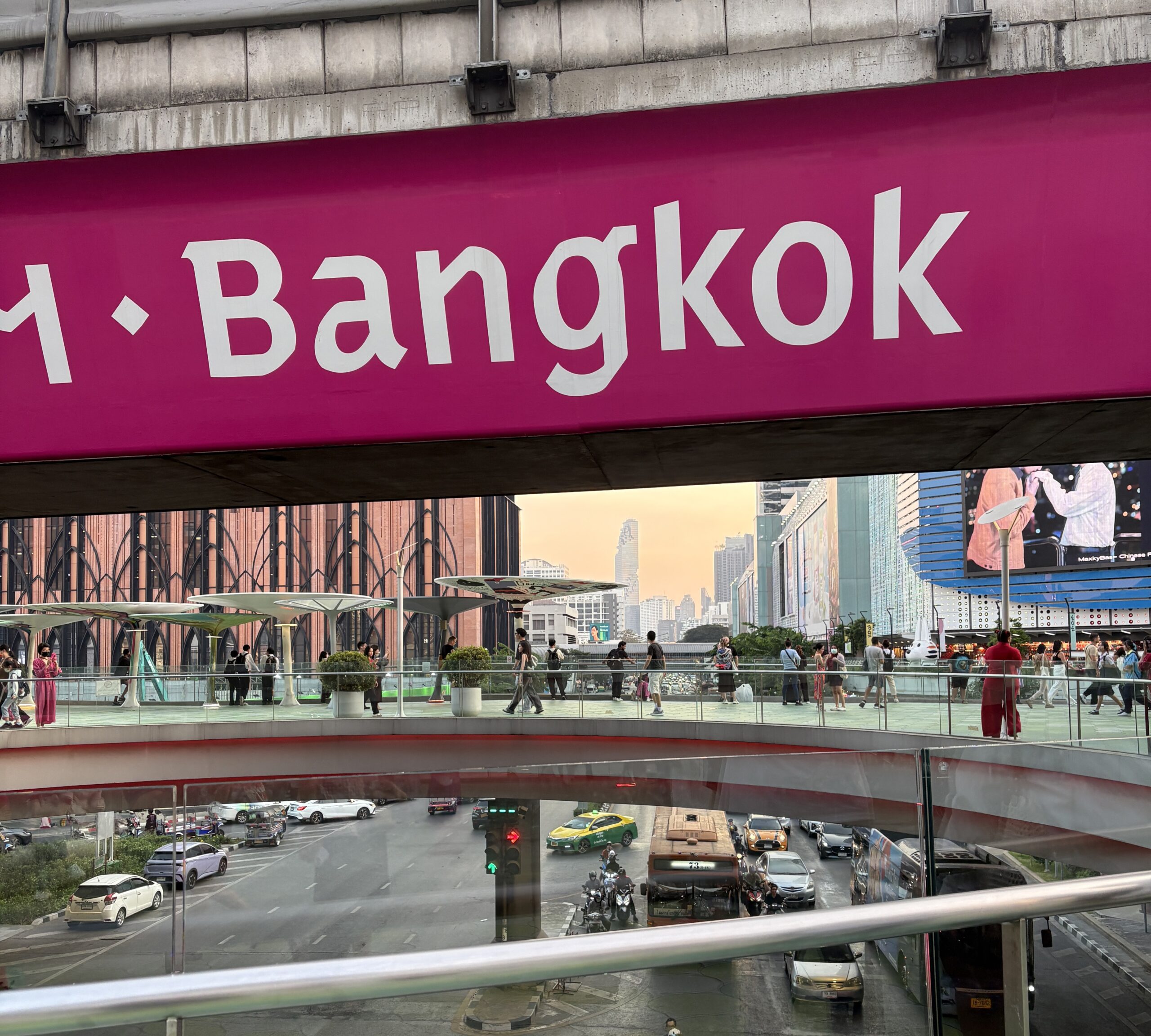How to Get Around Bangkok: 8 Best Ways
Bangkok is one of the most exciting cities in Asia, but figuring out how to get around Bangkok can feel overwhelming at first.
Between skytrains, river boats, motorbike taxis, and iconic tuk-tuks weaving through traffic, there are countless ways to navigate Thailand’s capital.
I’ve visited Bangkok several times, and once you know the system, getting around is easier than it looks. In this guide, I’ll share the best ways to navigate the city, avoid traffic headaches, and pick the right transport for your trip.
Whether you’re here for a short 4-day Bangkok itinerary, planning a longer Thailand adventure, or simply trying to avoid Bangkok’s infamous traffic, this guide will help you move through the city like a pro.
And if you’re still figuring out the best time to visit Bangkok, knowing when the city is at its most comfortable can make your visit smoother.
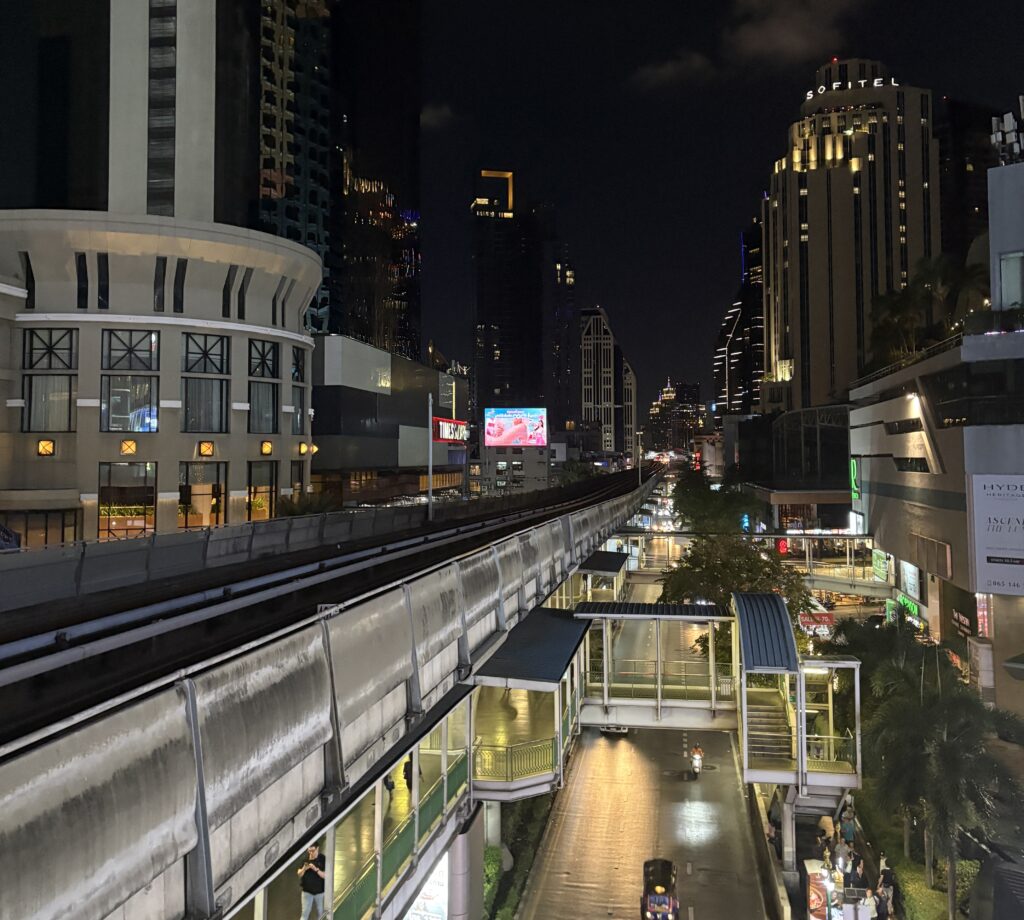
Getting from Bangkok Airports to the City
Before we dive into Bangkok transportation, for those who haven’t made it into the city yet, here are the most efficient ways to get from the airport to downtown.
Arriving in Bangkok means landing at either Suvarnabhumi (BKK) or Don Mueang (DMK), and getting into the city is surprisingly easy.
- Ride-Sharing Apps: Grab or Bolt works at both airports and avoids language barriers; prices are slightly higher than those of taxis at times, although sometimes the price is the same, all depending on rush hour.
- Airport Taxis: Both airports have official taxi stands. Fares to central Bangkok average 300–500 THB ($8–15) plus tolls and a 50 THB airport surcharge.
- Airport Rail Link (BKK only): Fast and cheap, this train connects Suvarnabhumi to the city center in about 30 minutes, with transfers to the BTS Skytrain at Phaya Thai.
- Airport Buses: Don Mueang has the A1 and A2 buses to Mo Chit BTS; BKK offers S1 buses to Khao San Road. They’re the cheapest option, but slower with luggage.
Ride-Sharing Apps in Bangkok

If you’re new to the city, ride-sharing apps are the easiest and most comfortable way to get around Bangkok. Grab is the most popular option in Thailand, followed by Bolt and inDrive, which sometimes offer slightly lower fares.
I use Grab and Bolt constantly in Bangkok, and both are super reliable. My usual trick is to check the price on both apps and pick whichever is cheaper at the moment. Most of the time, they’re very close, but during busy hours or rain, one might give you a better deal.
If I’m not in a rush, I sometimes use inDrive, where you can propose your own fare and see if a driver accepts. It can save you a bit of money, but you might wait longer for a pickup compared to Grab or Bolt.
The best part? The apps automatically calculate fares and show your driver’s route in real time, which is helpful in a city with Bangkok’s famously chaotic traffic. Just note that surge pricing can kick in during peak hours (think rush hour or rainy evenings).
If you’re arriving late at night or just want a stress-free first ride into the city, a ride-sharing app is the simplest way to start your Bangkok adventure.
Using the BTS Skytrain
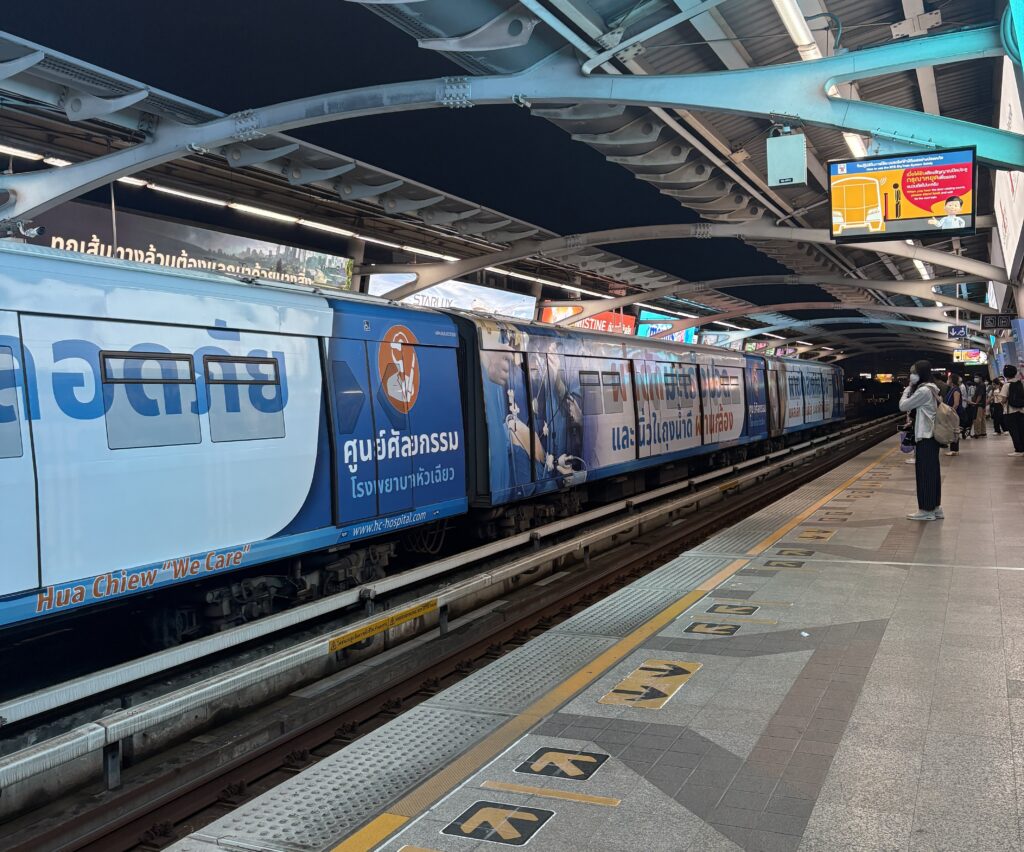
The BTS Skytrain is one of my favorite ways to get around Bangkok. It’s fast, efficient, air-conditioned, and avoids the city’s notorious traffic jams.
Here’s my biggest tip: get a Rabbit Card. You can buy one at any BTS station with your passport or a photo of it for about ฿200. Half of that goes toward the card itself, and the other half is stored as credit.
Once you have it, you can top it up with cash at the booth or machines and skip the long ticket lines entirely, especially during rush hour when every second counts.
If you’re a frequent visitor to Thailand, the card is valid for seven years, so it’s an easy investment that will save time every trip. The BTS is especially convenient if you’re staying in central Bangkok, and it connects directly to the MRT subway for easy citywide travel.
Operating hours run roughly from 6:00 AM to midnight, which covers almost any sightseeing, shopping, or nightlife plans without worrying about getting stranded.
If you’d like to experience the many top activities in Bangkok for first-timers, you’ll want to get the hang of using the BTS Skytrain.
Navigating the MRT Subway
Bangkok’s MRT subway complements the BTS perfectly and is another reliable way to explore the city without fighting traffic.
One huge time-saving hack: if you have a contactless Visa card, you can simply tap in and out instead of waiting in long lines for tokens or paper tickets.
I see tourists queueing for 10–20 minutes while locals and frequent travelers just walk through.
That said, keep an eye on your belongings. The MRT has signs warning about pickpockets, and while I’ve never had an issue, I always stay alert. A small crossbody bag or zippered backpack works best.
The MRT runs from about 6:00 AM to midnight, making it convenient for nearly all daytime activities, night markets, and even late dinners. It also connects seamlessly with the BTS, letting you cross the city quickly and avoid traffic at almost any hour.
For daily commutes, I love combining the BTS and MRT to get pretty much anywhere efficiently and cheaply.
Taking Regular Taxis in Bangkok
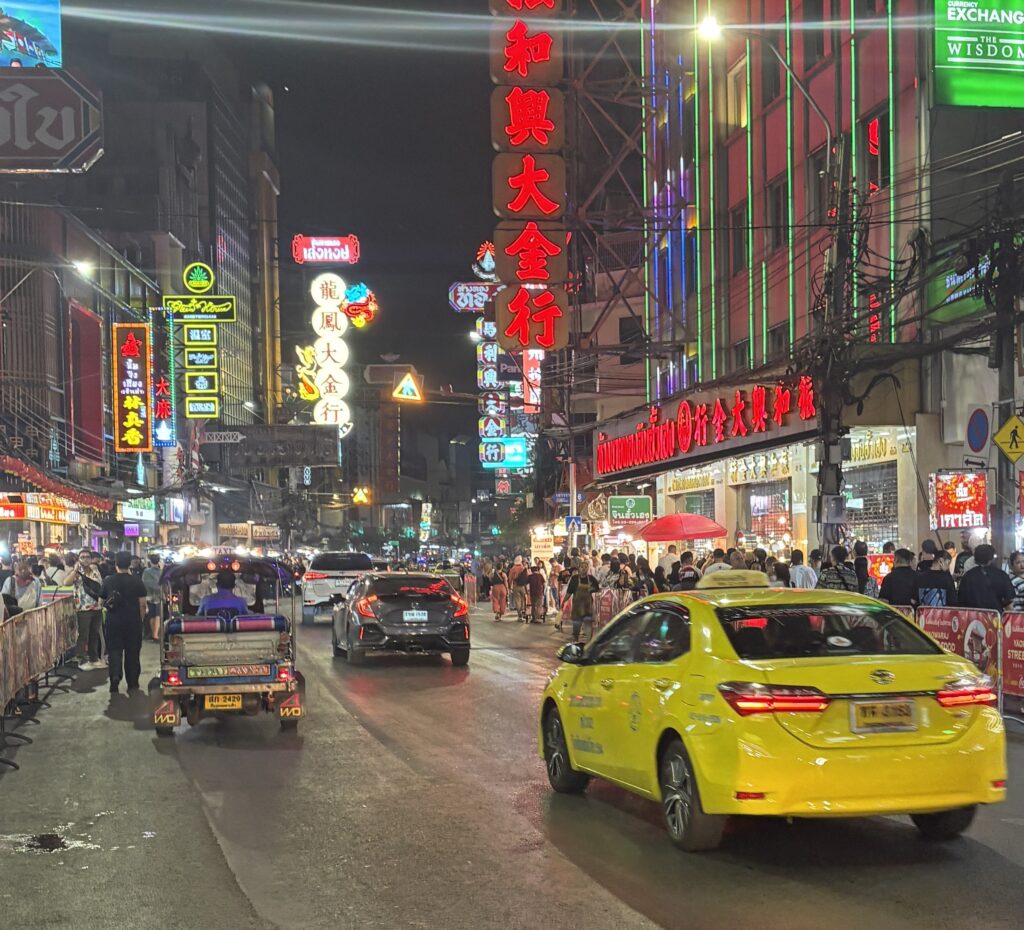
Regular taxis are everywhere in Bangkok, but the golden rule is to always ask for the meter. If the driver refuses, I usually just call a Grab or Bolt instead on your phone.
Taxis are a decent option late at night when trains stop running or if you’re carrying luggage, but traffic can turn a short ride into a long crawl.
I like to check Grab for a price estimate first, even if I plan to hail a cab, so I know roughly what’s fair.
Tuk-Tuks and Motorcycle Taxis
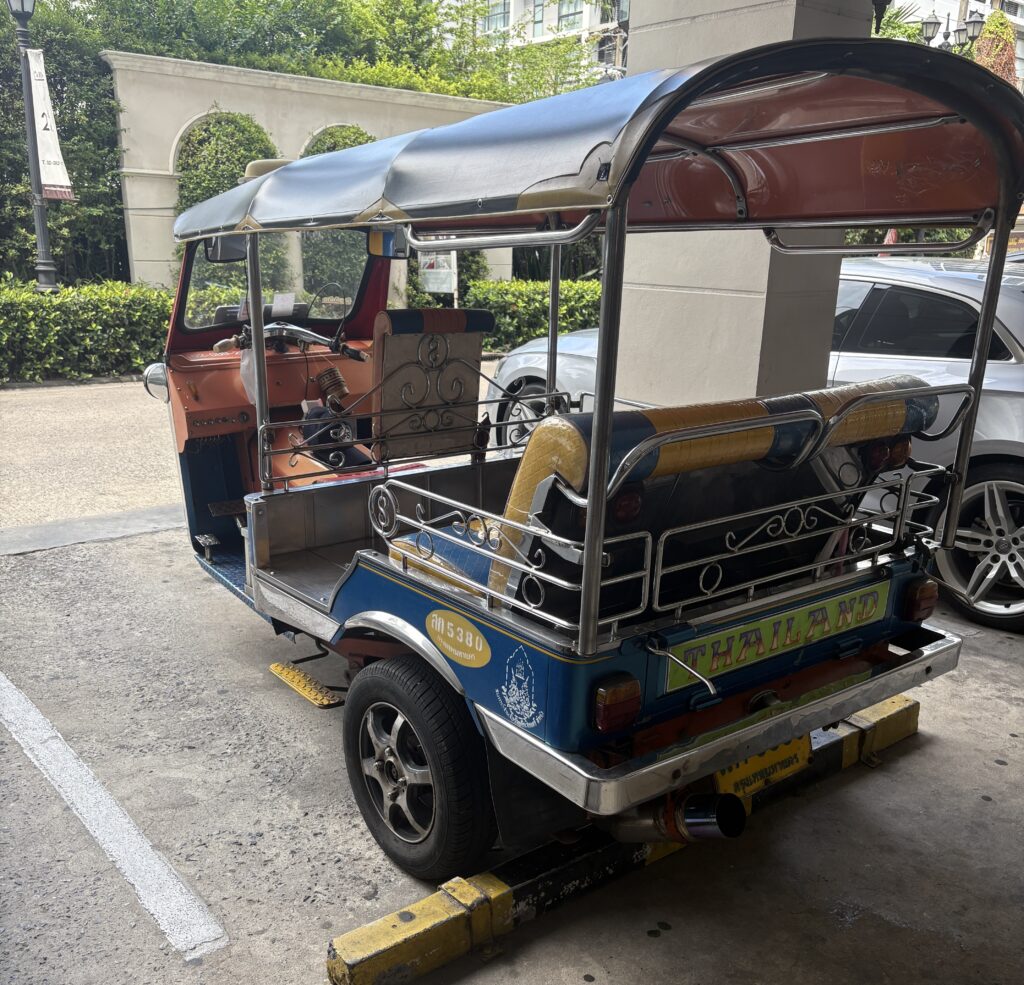
Tuk-tuks are iconic, fun, and very much a tourist experience. Always negotiate the fare before hopping in.
Here’s what I do if I want to take a tuk-tuk in Bangkok: I check Grab first to see the car fare and use that as a baseline, but expect to pay a little more than Grab for the tuk-tuk experience, wind in your hair, and Bangkok streets whizzing by.
Be cautious of common scams, like drivers offering cheap rides that include “special shop” stops for commissions. Please stick to your plan, and check Google Maps to ensure they’re going the right way.
Motorcycle taxis are better for quick, short hops, especially in traffic. Just know they’re not for the faint of heart, helmets are a must, and it’s a thrilling, bumpy ride through the city. If you’re looking for speed over comfort, motorcycles will beat the traffic every time.
Bangkok Public Buses
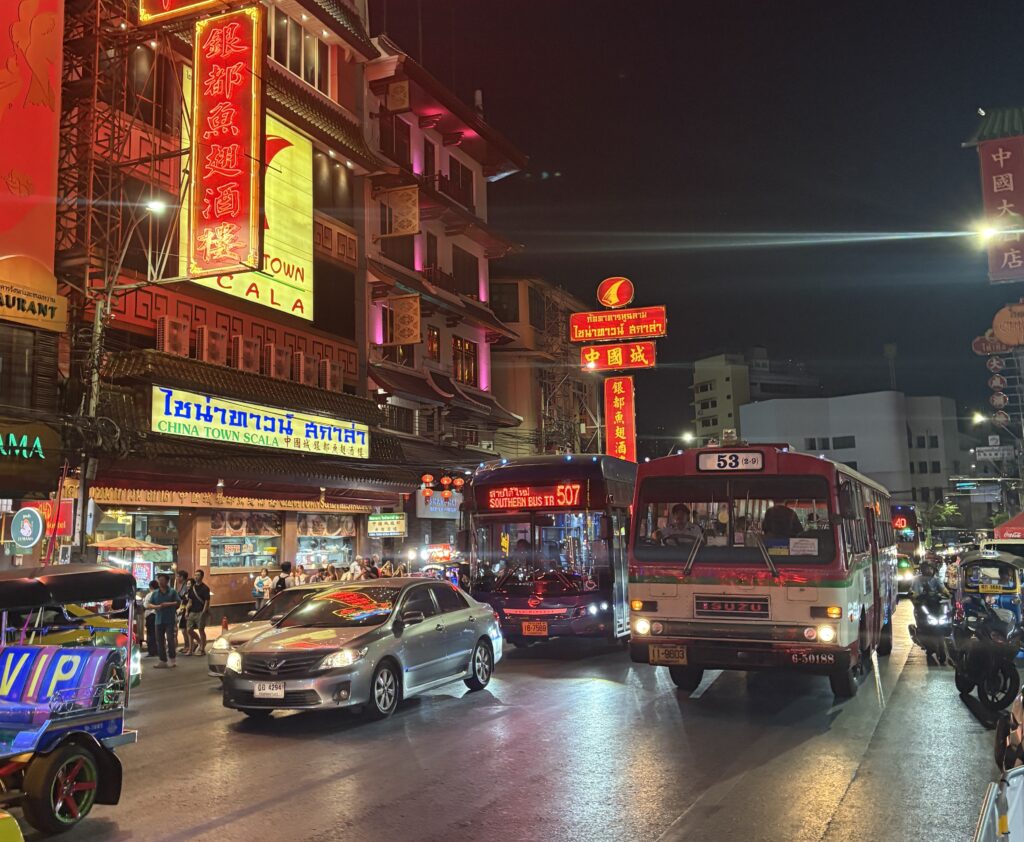
Bangkok’s public buses are the most budget-friendly way to get around the city, but they’re also the slowest and most confusing for first-time visitors.
Routes are primarily in Thai, and traffic can make even short distances take a long time.
If you’re traveling on a tight budget and not in a rush, buses can be an adventure in themselves, offering a glimpse of daily local life.
However, for most tourists, I only recommend them if you’re comfortable navigating without English signage or you’re traveling with a local friend.
Exploring Bangkok by Canal Boats
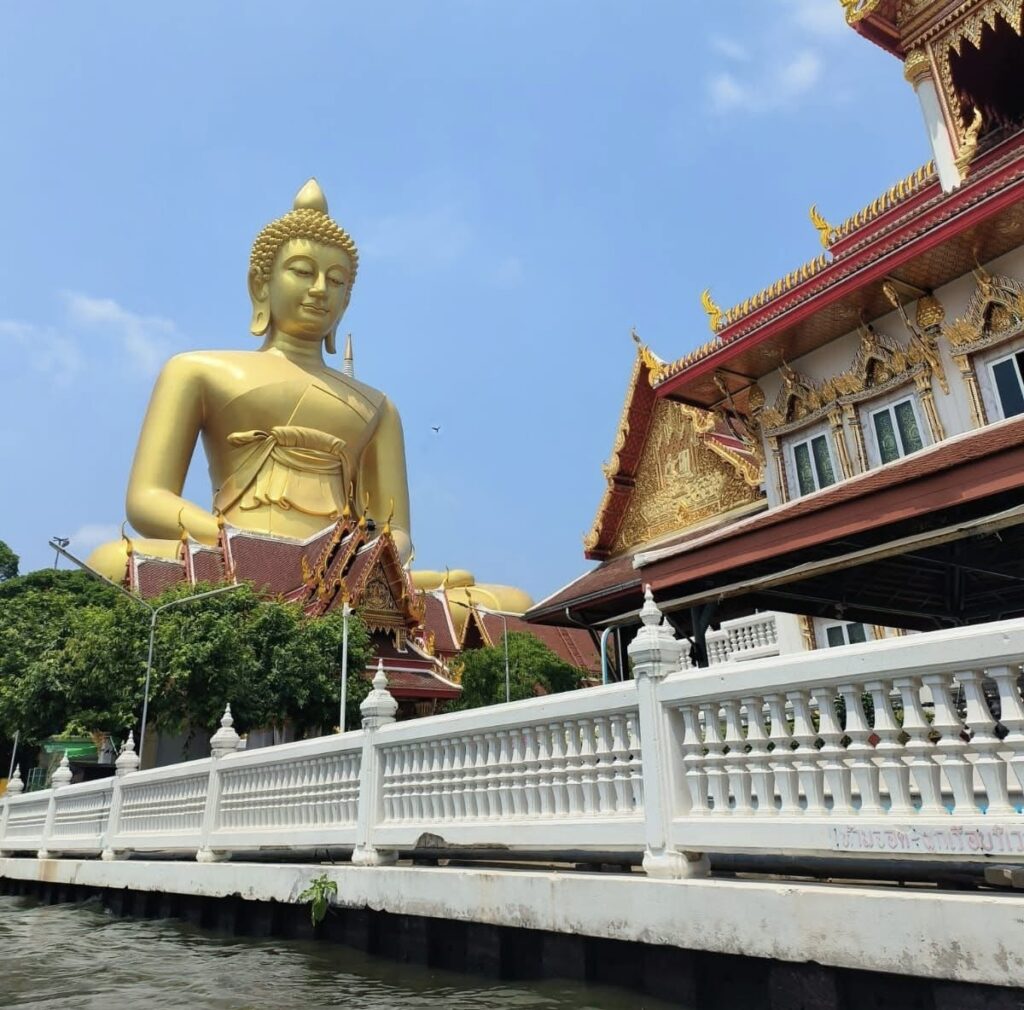
Bangkok used to be called the “Venice of the East,” and you can still experience that charm via the canal boats, known as khlong boats.
They’re scenic, cheap, and a great way to avoid gridlock while seeing a different side of the city.
Routes like the Saen Saep canal can take you from the Old City to modern malls without touching a traffic jam.
The only downside: the boats can be noisy, wet, and tricky to board, so wear comfortable shoes and keep valuables secure.
Renting a Car or Scooter
I’ll be blunt, driving in Bangkok isn’t worth it for most travelers. Traffic is chaotic, parking is limited, and public transport is far easier.
The only time I’d consider renting is if I were planning trips outside the city or staying for a few weeks. If you do rent, make sure you have a valid international driver’s permit and proper travel insurance.
Scooters can be convenient for neighborhoods on the outskirts, but for short visits, Grab or public transit is safer and more efficient.
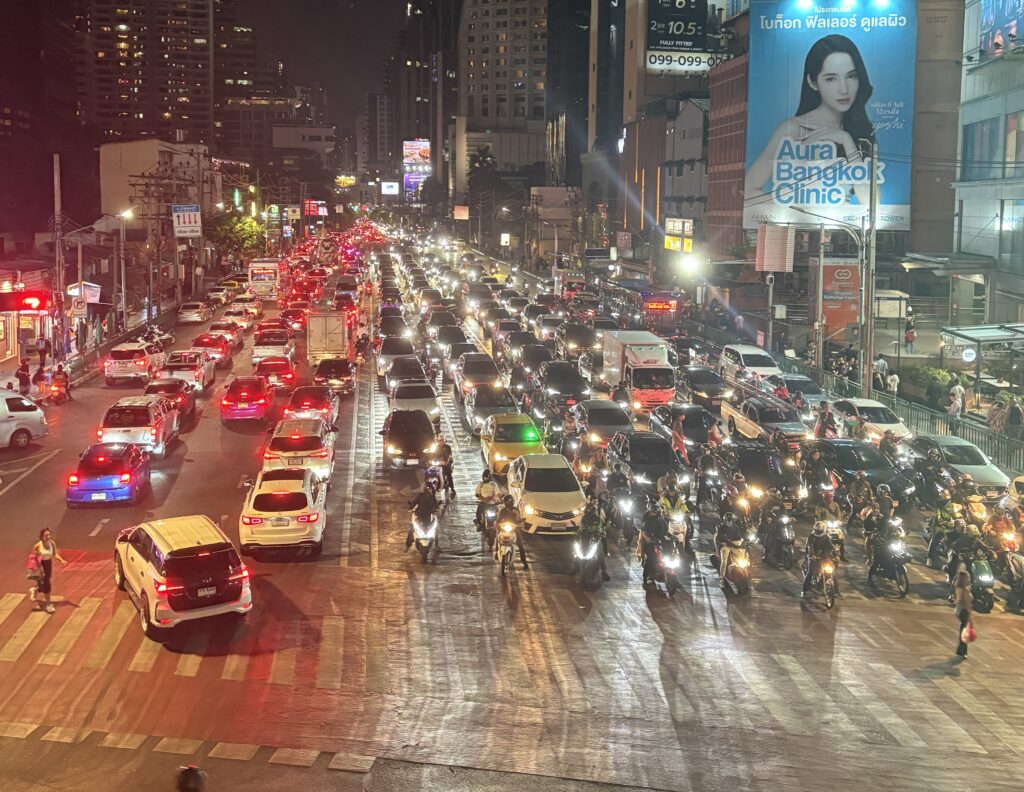
How to Choose the Best Option
Before you even think about which transportation method to use, the smartest move is choosing the right area to stay in Bangkok.
If you haven’t booked yet, my guide on the best areas in Bangkok to stay in will help you pick a spot near a BTS Skytrain station, which is the ultimate travel hack for this city.
When you’re close to a BTS station, you can zip around the city quickly, cheaply, and without the headache of traffic. The BTS connects seamlessly with the MRT subway, covering most major neighborhoods and tourist attractions.
Between these two systems, you can handle 80% of your transportation needs with speed and ease.
From there, Grab or Bolt fills in the gaps for places the train doesn’t reach, while tuk-tuks are best saved for the occasional fun ride rather than daily transport.
The bottom line: where you stay dictates how easy and cheap it will be to get around Bangkok. Pick smart, and your whole trip becomes smoother.
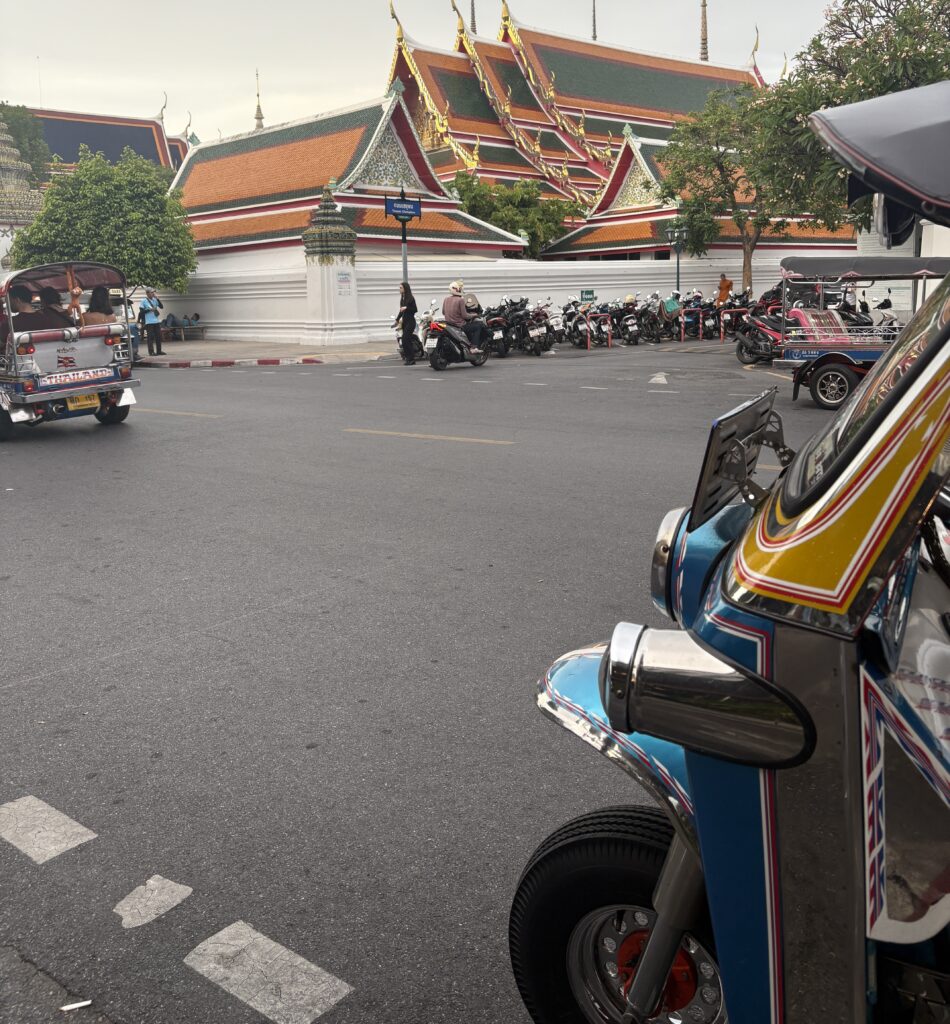
Safety Tips for Getting Around Bangkok
Bangkok is generally safe for travelers, but following a few habits will help you avoid stress and save money.
Bangkok is generally safe for travelers, but following a few travel tips in Thailand will help you avoid stress and save money.
- Use Grab or Bolt at night: Prices for tuk-tuks and taxis almost always rise after dark, especially if you’re leaving areas like Chinatown, Asiatique, or the night markets. Ride-hailing apps prevent overcharging and save you the hassle of haggling.
- Expect higher prices late at night: If you do take a tuk-tuk or taxi, know that drivers often raise rates after hours. Check the fare on Grab first to set a baseline, but be ready to pay slightly more for the “tourist experience.”
- Carry small bills: Drivers rarely have change, and some may “forget” to return it. Keeping 20s, 50s, and 100 baht notes handy avoids awkward situations.
- Watch for pickpockets in crowded spots. MRT stations, night markets, and busy streets are the main areas to be cautious in. Keep phones and wallets close, ideally in a crossbody bag.
- When walking after dark, stick to well‑lit streets and busy areas; this is where Bangkok’s nightlife safety tips really come into play.

Final Thoughts: Bangkok Transportation Options
Bangkok’s public transportation is nothing to fear; it’s not even a smidge as intimidating as Tokyo’s. Getting around Bangkok can feel intimidating at first, but once you understand the system, it’s surprisingly simple.
I’ve visited many times, on both short trips and extended stays, and I’ve noticed some travelers hesitate to use public transportation. Here’s the truth: Bangkok’s BTS Skytrain and MRT Subway are among the easiest and most reliable systems I’ve used anywhere.
Don’t avoid them, they’ll save you time, money, and stress. If you’re ever unsure, station security, locals, or fellow travelers are usually happy to point you in the right direction.
The BTS and MRT cover most of central Bangkok, while Grab or Bolt are perfect for luggage runs or late‑night rides. Tuk‑tuks are fun for short joy rides, but not your main transport.
My top tip for Bangkok: Stay near a BTS or MRT station. It eliminates most transportation headaches and lets you explore the city efficiently.
If Bangkok is just one stop on a longer trip, my 2 Week Thailand Itinerary is a great reference for mapping out smooth connections between cities.
Once you match the right transport option to your style, Bangkok becomes far more enjoyable; you’ll save hours, move like a local, and enjoy the journey as much as the destination. And if your trip continues south, learning the ins and outs of getting around Phuket will make the island just as easy to navigate.
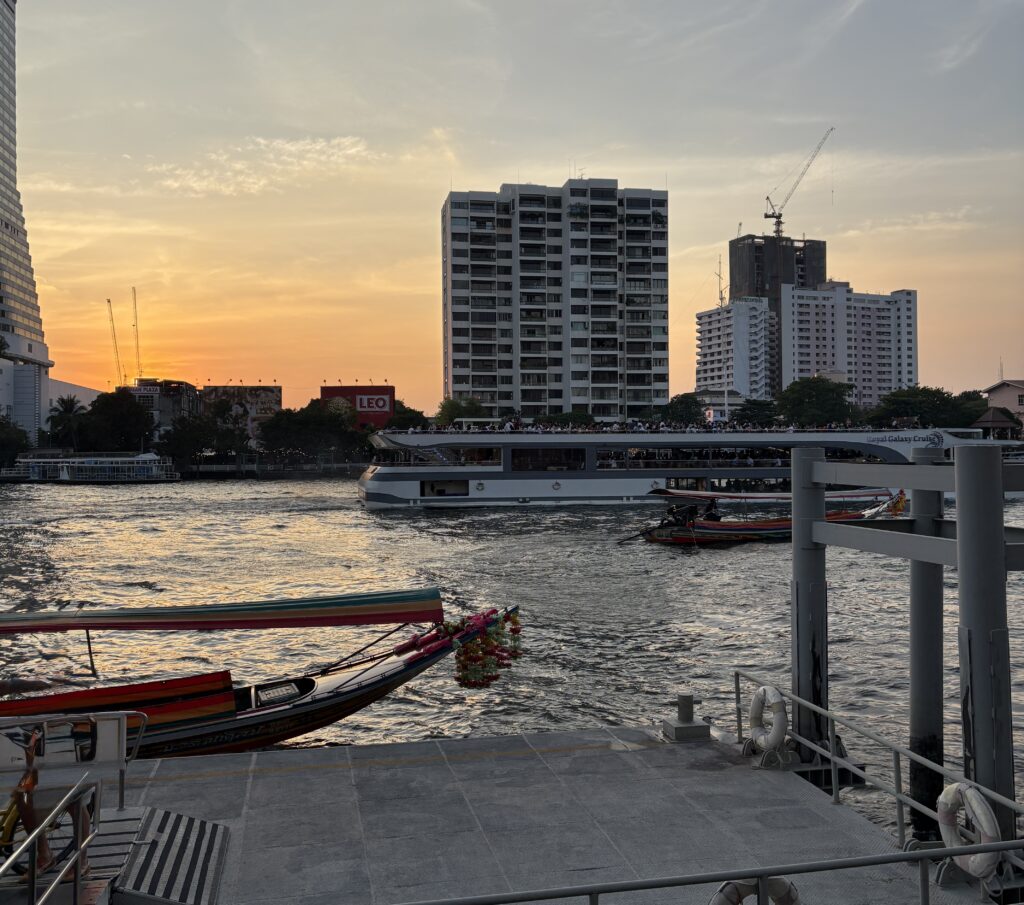
What are BTS and MRT operating hours?
BTS Skytrain runs from 6:00 AM to midnight, while the MRT Blue Line follows the same schedule, with the Purple Line starting around 5:30 AM, depending on the day, which is excellent for early starts or late-night sightseeing.
Do I need to buy tickets for BTS and MRT every time?
No. Buy a Rabbit Card at any BTS station with your passport or a photo for about ฿200 (฿100 card fee + ฿100 stored credit). Reload it with cash at booths or machines and skip the ticket lines during rush hours. It’s valid for up to seven years, a real travel hack.
Are pickpockets a real issue on Bangkok’s trains?
Although rare, pickpocketing can occur in crowded MRT stations and during busy times. Stations for the MRT even have signs warning tourists, so be cautious.
What is the cheapest way to get around Bangkok?
The cheapest option is taking public buses or canal boats, which cost just a few baht per ride. They’re slower and require some patience, but they’re great if you want a local experience and don’t mind skipping air‑conditioning.
For short hops, motorbike taxis are also affordable, especially outside peak tourist areas.

